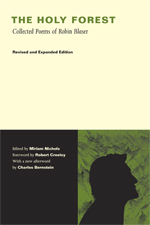
This piece is being published simultaneously in The Poetry Project Newsletter.
I dwell in Possibility—
A fairer House than Prose—
— Dickinson
Robin Blaser’s poems are companions on a journey of life, a journey
whose goal is not getting someplace else, but, rather, being where you
are and who you are – where you is always in the plural.

In the plural might be a good motto for Blaser’s
courageous and anti-declamatory poetics, his profound continuation,
deep into the darkening heart of contemporary North American poetry, of
Emily Dickinson’s core value: “I’m nobody … Are you nobody too?” For
Blaser, it is not only nobody but also no mind, or “no” mind, for this
is a poetics of negation that dwells in pleats and upon folds. Pleating
and folding being Blaser’s latter day, Deleuzian, manner of extending
his lifelong project of seriality.
One poem must follow instanter on the next, a next always out of reach until in hand, in mouth, in ear.
Blaser celebrated his 80 birthday on May 14, 2005, just as this book was going into final production.
The present edition, an expanded version of the 1993 coach house press
publication of the same name – Blaser’s first collected poems –
features a number of poems from the last decade and also includes
several significant works not included in the Coach House
publication. Most significantly, Blaser has added a recent long
poem for Dante to his Great Companion series. This astounding work
provides a bridge between Blaser’s poems and critical writings, marking
a direct point of contact to the University of California’s companion
volume of Blaser’s collected essays.
Blaser’s work constitutes a fundamental part of the fabric of the
North American poetry and poetics of “interrogation,” to use his term.
Compared to his most immediate contemporaries, Blaser has pursued a
different, distinctly refractory, willfully diffuse, course that has
led him to be circumspect about publication. As a result, it was almost
40 years from his first poems to the time when The Holy Forest
began to emerge as one of the key poetic works of the present. Indeed,
Blaser’s lyric collage (what he calls “the art of combinations” in a
poem of that title, alluding to Leibnitz) seems today to be remarkably
fresh, even while his engagement with (I don’t say commitment to)
turbulence and turbulent thought seems ever more pressingly exemplary.
Blaser’s work seems to me more a part of the future of poetry than the
past.
Blaser’s poems and essays insist on the necessity of thinking
through analogy and resemblance – that is, thinking serially so as to
move beyond the epistemological limits of positivism and
self-expression. At the same time, Blaser has committed his work to
everywhere affirming the value of human diversity, understood not only
as sexual or ethnic difference, but also as the possibility of thinking
outside received categories. There are some remarkably powerful and
explicit political poems in the volume, notably “Even on Sunday.” But
the most radical politics of this work goes beyond any one poem: it is
inscribed in the work’s compositional practice. Even as Blaser
questions the stable, lyric, expressive “I,” he never abandons the
possibility of poetic agency, through his generative recognition of
language as social, as the “outside.”
Blaser’s “Great Companions” have now gone into the world of an
ever-present no-longer-of-this-life: Jack Spicer, Robert Duncan, Robert
Creeley, Charles Olson, of his immediate company; Dante, Nerval,
Merleau-Ponty, Deleuze of his Imaginary. The poems of the Holy Forest
are points on a map of a cosmos that does not exist in historical
terms, that cannot exist, yet that must exist, if we are to make it to
a Century 22 that is more than the name of a clothing store. The points
form a constellation that we are not quite ready to apprehend but
through which we are already formed. We grope and we stumble, but then,
out of the blue or black or ultra suede, something unexpected happens:
we are ensnared by the encounter.
Form finds us. Form founds us.
Blaser’s Holy Forest is a blaze of allusion without
symbols, quotation without appointment. In the forest of language,
every tree is a poem, every leaf a word. The poet sings the songs of
night, jumping, from branch to branch, to a syncopated beat; never,
ever, finding home. “To wit – to woo – to wound – ,” Blaser writes in
“Oh!,” one of his late, short, I want to call them anti-lyrics.
Citation, citation everywhere: the utter prism of his care.
No other moment exists but this one.
This one.
This one.
The Holy Forest is wholly secular, for
only the secular allows the promise of an end to what Blake knew
as the Totalizing Oppression of Morality. (“We have paid far too much in
terror,” Blaser writes in a note to his Dante poem, “for our
totalities.”) Each line of The Holy Forest is a
glimpse into the unknown, each poem a new way of entering the
holiness of the everyday. The frames are restless: no conclusion
nor solution, the only resolution the necessity to go on. “We
enter a territory without totalities where poetic practice is
our stake and necessity.”
“This World is not conclusion / A sequel stands beyond,” writes
Dickinson.
Neither is the poem the end of the poem, nor is the idea of the poem its origin.
The poem is the possibility of possibility.
In his exquisite articulations of the flowers of associational thinking, Blaser has turned knowledge into nowledge,
the “wild logos” of the cosmic companionship of the
real.